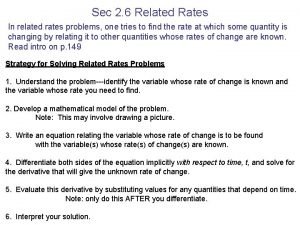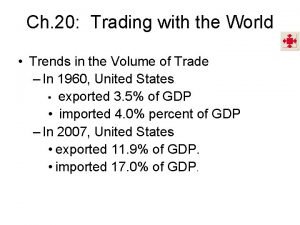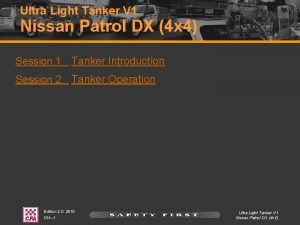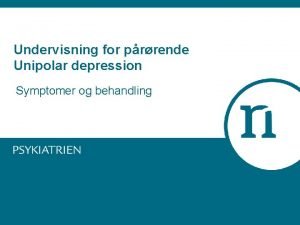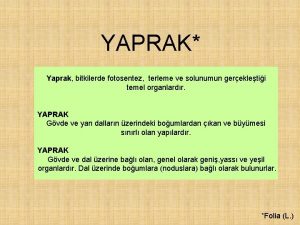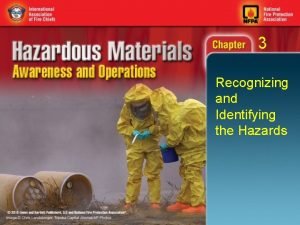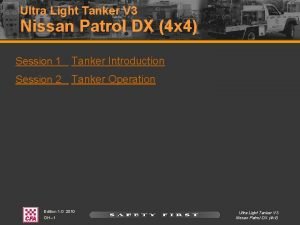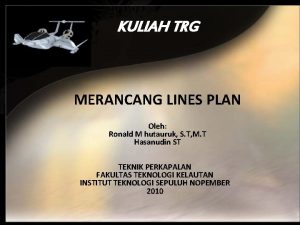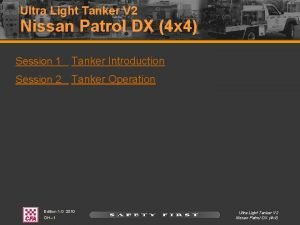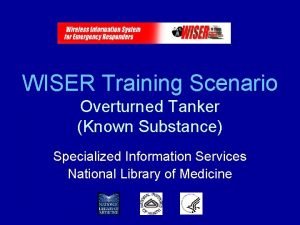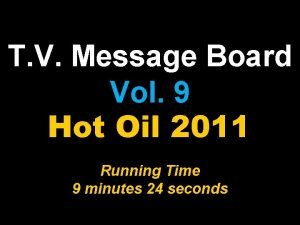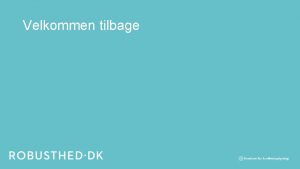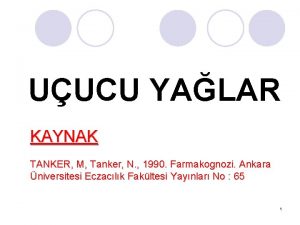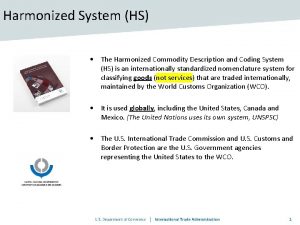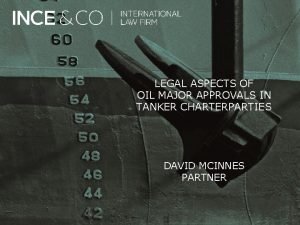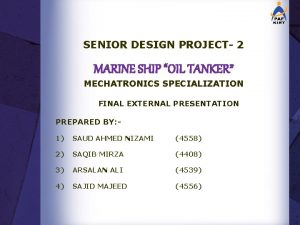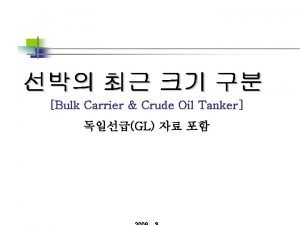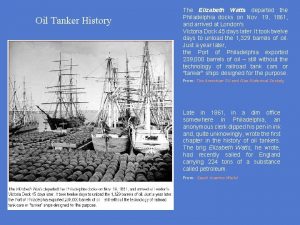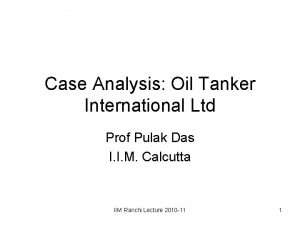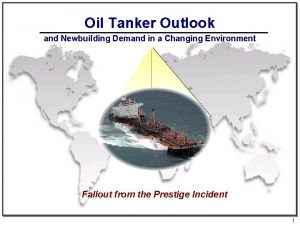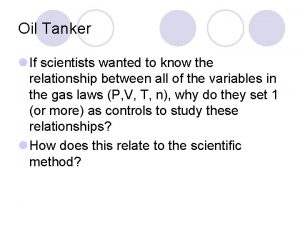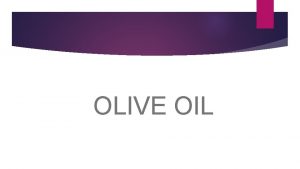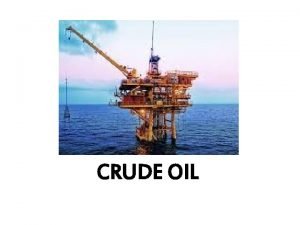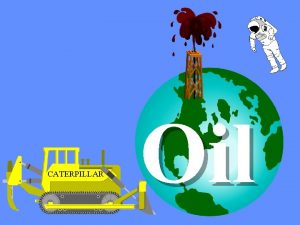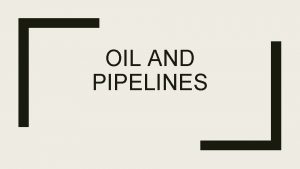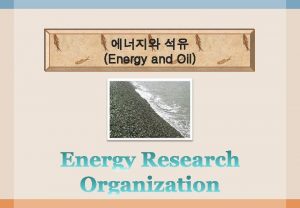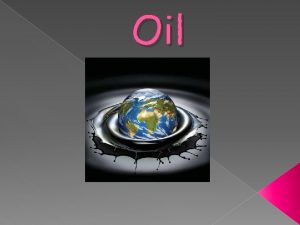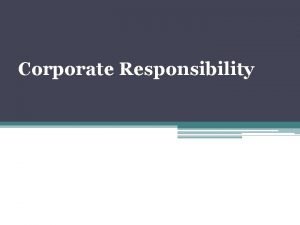Impact of Harmonized CSR for Oil Tanker Unchul




























- Slides: 28

Impact of Harmonized CSR for Oil Tanker Unchul Choi October 26, 2016

1. Introduction CSR - H PRESCRIPTIVE RULE CHANGES EXTENDED SCOPE OF FE ANALYSIS

1. Introduction Impact on design of 158 K DWT COT Length B. P. 267 m Breadth 48 m Depth 23. 1 m Draught (Design) 16 m Draught (Scantling) 17. 15 m

2. Prescriptive Rule Change 2. 1 Corrosion Addition of Shell Plate 2. 2 Green Sea Load 2. 3 Internal Tank Pressure at Seagoing Condition 2. 4 Bottom Slamming Region 2. 5 Minimum Thickness

2. Prescriptive Rule Change 2. 1 Corrosion Addition of Shell Plate Compartment type CSR Shell plating : 1. 0 mm Exposed to Seawater CSR-H Shell plating : 1. 0 mm Between minimum design Quay contact region ballast draught and (below figure) : 1. 5 mm scantling draft : 1. 5 mm Fig. Quay contact region of CSR

2. Prescriptive Rule Change 2. 2 Green Sea Load Position CSR-H Mid Hold 58 k. N/m 2 73 k. N/m 2 47% more than CSR in mid hold area Reinforcement of deck transverse

2. Prescriptive Rule Change 2. 3 Internal Tank Pressure at Seagoing Condition Position CSR-H Cargo Tank Internal static pressure + Internal dynamic pressure + Relief valve pressure (25 k. N/m 2) – 25 k. N/m 2 Internal static pressure + Internal dynamic pressure + Relief valve pressure(25 k. N/m 2) 25 k. N/m 2 more than CSR in Internal tank pressure at seagoing condition Reinforcement of cargo tank boundary( figure on next page)

2. Prescriptive Rule Change Fig. Positions to be reinforced due to increased tank pressure

2. Prescriptive Rule Change 2. 4 Bottom Slamming Region Position CSR-H Maximum Pressure Region 0. 125 L ~ 0. 05 L from F. P. 0. 122 L ~ 0 L from F. P. Extended region Reinforcement of bottom shell forward of F. P. BHD

2. Prescriptive Rule Change 2. 5 Minimum Thickness Position CSR-H Impact on design Side Shell i. w. o ER and AFT Part 4. 5 + 0. 03 L 2 7. 0 + 0. 03 L 2 18. 0 mm with corrosion addition of 3. 0 mm Inner Bottom 4. 5 + 0. 02 L 2 5. 5 + 0. 03 L 2 16. 5 mm with corrosion addition of 3 mm Stringer in WBT 5. 0 + 0. 015 L 2 0. 6 L 21/2 12. 5 mm with corrosion addition of 3 mm Keel Plating - Not to be less than the adjacent plating - Sheer Strake - Not to be less than the adjacent side plating - Deck Stringer Plating - Not to be less than the adjacent deck plating -

2. Prescriptive Rule Change Fig. Positions to be reinforced due to minimum thickness requirement

3. Extended Scope of FE Analysis 3. 1 Cargo Hold Analysis 3. 2 Fine Mesh Analysis 3. 3 Fatigue Analysis

3. Extended Scope of FE Analysis 3. 1 Cargo Hold Analysis Position CSR-H O O - O Aft cargo hold region No. 3 ~ 5 Hold No. 6 Hold and Slop Tank - - O Forward cargo hold region No. 2 Hold - O Forward most cargo hold region No. 1 Hold - O Mid hold region Aft most cargo hold region Fig. Definition of Cargo Hold Regions for FE Analysis in CSR-

3. Extended Scope of FE Analysis Position Impact Mid hold region No. 3 ~ 5 Hold Reinforcement due to increased cargo tank pressure in sea going condition Aft most cargo hold region No. 6 Hold and Slop Tank Buckling reinforcement on bottom shell plating (refer to next page) Forward cargo hold region No. 2 Hold Same with mid hold region Forward most cargo hold region No. 1 Hold No impact

3. Extended Scope of FE Analysis Fig. Buckling Reinforcement at Bottom Shell Plating forward of E/R BHD

3. Extended Scope of FE Analysis 3. 2 Fine Mesh Analysis Position CSR-H Upper hopper knuckle Mandatory Lower hopper knuckle - Mandatory Toe of PSM or large bracket Mandatory Screening Heel of stringer Mandatory Screening Opening Large opening only (i. e. opening for inclined ladder) Manhole (every opening) with screening Connection between transverse BHD and double bottom and deck longitudinal Mandatory Extended Cargo Hold Analysis Region - Screening

3. Extended Scope of FE Analysis Fig. Areas for Fine Mesh Analysis after Screening

3. Extended Scope of FE Analysis Fig. Areas for Fine Mesh Analysis after Screening

3. Extended Scope of FE Analysis Fig. Areas for Fine Mesh Analysis after Screening

3. Extended Scope of FE Analysis Impacts of CSR-H Position Impact Lower hopper knuckle No impact Toe of PSM or large bracket Heel of stringer Reinforcement due to increased cargo tank pressure in sea going condition Opening No impact Extended Cargo Hold Analysis Region No impact

3. Extended Scope of FE Analysis 3. 3 Fatigue Analysis Position CSR-H Lower hopper knuckle Mandatory Toe of PSM or large bracket - Screening Upper hopper knuckle - Detail design standard Heel of stringer iwo double side - Detail design standard

3. Extended Scope of FE Analysis Fig. Hot Spots for Fatigue Analysis

3. Extended Scope of FE Analysis Fig. Hot Spots for Fatigue Analysis

3. Extended Scope of FE Analysis Reinforcement due to Fatigue Analysis Position Lower hopper knuckle Inner bottom plating Toes at typical web section Toe of PSM or large bracket Upper Hopper Knuckle Heel of stringer iwo double side Reinforcement + 2 mm No reinforcement + more than 10 mm with insert Toe at no. 1 stringer iwo double plate at inner hull BHD and side thinner face plate (e. g. 350 x 30 FB 450 x 24 FB) Toes at other position of stringer + 5 ~10 mm with thinner face plate Upper Hopper Knuckle Detail design standard Heel at no. 1 stringer Detail design standard (800 x 25 AH/600 R) with toe grinding Heel at no. 2 stringer Smooth bracket with face plate with toe grinding Heel at no. 3 stringer No reinforcement

3. Extended Scope of FE Analysis Fig. Design of Stringer Toe End for Fatigue Strength

4. Conclusion l Main design change item ü Internal tank pressure Thickness increase at cargo tank boundary ü Minimum thickness Thickness increase at shell plating iwo ER and stringer plating ü Aft most cargo hold analysis Thickness increase at Bottom Shell forward of E/R BHD ü Fatigue analysis Stringer design change

4. Conclusion Impacts of CSR-H Item Impacts Corrosion addition in shell plate Prescriptive rule change Green sea load - Increased weight(around 1% of hull weight) - Increased analysis time and manpower Increased time of class approval Internal tank pressure Bottom slamming region Minimum thickness Mid hold analysis Aft most cargo hold analysis Extended scope of FE analysis Forward cargo hold analysis Forward most cargo hold analysis Fine mesh analysis Fatigue analysis -

Q & A
 Related rates baseball diamond
Related rates baseball diamond Harmonized tarriff schedule
Harmonized tarriff schedule Harmonized approach to cash transfers
Harmonized approach to cash transfers Harmonized commodity description and coding systems
Harmonized commodity description and coding systems Harmonized salary structure
Harmonized salary structure Primary emulsion formula
Primary emulsion formula Light tanker for supplying water
Light tanker for supplying water Omstrukturering af negative tanker
Omstrukturering af negative tanker Yaprak ayası
Yaprak ayası Mc-338 cryogenic tankers
Mc-338 cryogenic tankers Computer set an/uyk-128(v)3
Computer set an/uyk-128(v)3 Lines plan kapal tanker
Lines plan kapal tanker Light tanker for supplying water or fuel
Light tanker for supplying water or fuel Hazmat over turned tanker training
Hazmat over turned tanker training Message hot oil
Message hot oil Redogör för vad psykologi är
Redogör för vad psykologi är Bästa kameran för astrofoto
Bästa kameran för astrofoto Karttecken brunn
Karttecken brunn Svenskt ramverk för digital samverkan
Svenskt ramverk för digital samverkan Nyckelkompetenser för livslångt lärande
Nyckelkompetenser för livslångt lärande Multiplikation med uppställning
Multiplikation med uppställning Tidbok
Tidbok Kontinuitetshantering
Kontinuitetshantering Orubbliga rättigheter
Orubbliga rättigheter Elektronik för barn
Elektronik för barn Ministerstyre för och nackdelar
Ministerstyre för och nackdelar Verktyg för automatisering av utbetalningar
Verktyg för automatisering av utbetalningar Bris för vuxna
Bris för vuxna Kanaans land
Kanaans land
